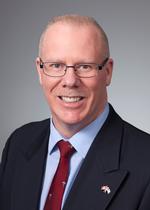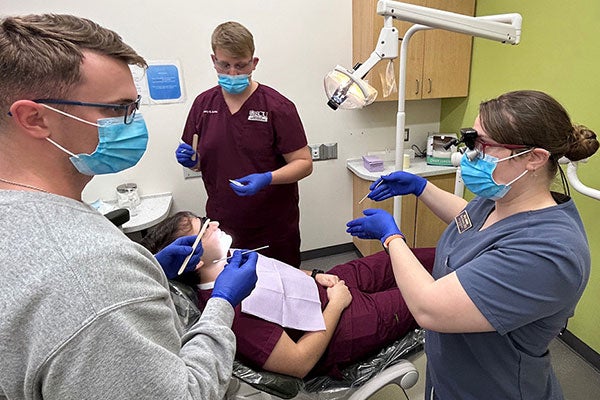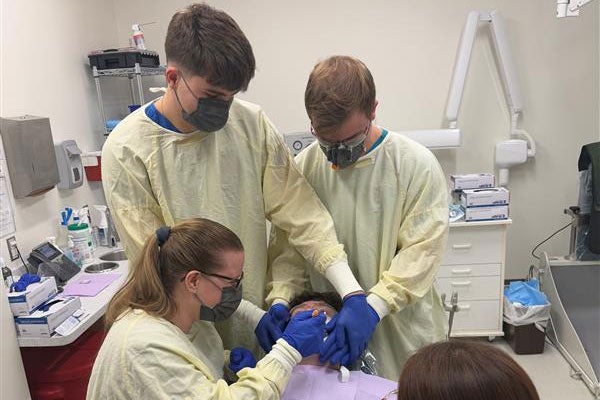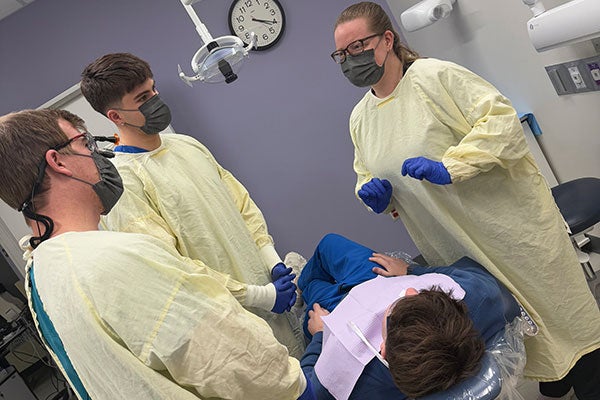Optional 2nd Year Advanced Education in General Dentistry (AEGD-2)
Program Overview from David G MacPherson, CD, MSc, DDS, FAGD, ABGD

The East Carolina University School of Dental Medicine offers an Optional 2nd-year Advanced Education in General Dentistry (AEGD-2) Residency. The program only accepts applications from those who are currently enrolled in or have already completed the East Carolina University School of Dental Medicine 1-Year Advanced Education in General Dentistry (AEGD-1) Residency program. The Optional 2nd Year program integrates didactic education and clinical experience at a level beyond the 1-Year program, with a view to broadening the Resident’s professional knowledge and clinical skills to the point that they can provide comprehensive oral healthcare for patients with more complex Dental needs. The Program is also designed to increase the Resident’s ability to coordinate with other healthcare professionals, both Medical and Dental, with a view to enhancing the Resident’s ability to provide oral healthcare for patients with Special Needs. The Program is also designed to promote the ideals of Community Service, and the need for ongoing and lifelong Continuing Professional Education.
The Optional 2nd Year AEGD program is unique in that it has been developed in conjunction with the East Carolina University’s College of Education (CoE), and the program includes the completion of the three core courses required for the CoE’s Graduate Certificate Program in Education in the Healthcare Professions. These courses have been specifically tailored towards Dental Education, thus this feature makes the Optional 2nd Year program ideal for those clinicians who wish to gain the advanced professional knowledge and clinical skills of a 2-Year AEGD, and who may be considering a potential future career in Dental Education.
The East Carolina University School of Dental Medicine’s Optional 2nd Year AEGD program is accredited by the American Dental Association’s Commission on Dental Accreditation.
For information about the program please read the Curriculum below, and if you would like more information please do not hesitate to contact me or the Program Coordinator via email.
Sincerely ,
David G. MacPherson, CD, MSc, DDS, FAGD, ABGD
ECU SoDM AEGD Program Director: macphersond17@ecu.edu
Elena Uzun, AEGD Program Coordinator: uzune21@ecu.edu
Curriculum
The ECU SoDM Optional 2nd Year AEGD Program integrates didactic education and clinical experience at a level beyond the 1-Year program, with a view to broadening the Resident’s professional knowledge and clinical skills to the point that they can provide comprehensive oral healthcare for patients with more and more complex Dental needs. The Program is also designed to increase the Resident’s ability to coordinate with other healthcare professionals, both Medical and Dental, with a view to enhancing the Resident’s ability to provide oral healthcare for patients with Special Needs. The Program is also designed to promote the ideals of Community Service, and the need for ongoing and lifelong Continuing Professional Education.
The ECU SoDM Optional 2nd Year AEGD Program is unique in that it has been developed in conjunction with the ECU College of Education (CoE), and includes the completion of the three core courses required for the CoE’s Graduate Certificate Program in Education in the Healthcare Professions. This feature makes the Optional 2nd Year program ideal for those clinicians considering a potential career as a Dental Educator, working as faculty in a Dental School.
Designed to meet the CODA Accreditation Standards for an Optional 2nd Year Advanced Education in General Dentistry Program, the ECU SoDM’s program consists of three major components and a Community Service requirement:
Orientation
The two-day orientation includes a program overview and on-boarding administration and registration, as well as hands-on training in the Management of Medical Emergencies.
The Clinical Program
The Clinical Program consists of 241 scheduled clinic days with the following components:
- Advance Care Clinic. Provision of care in the Advanced Care Clinic in Ross Hall, under the supervision and mentorship of the AEGD Program Director, AEGD Faculty, and specialist faculty as indicated.
- Oral Surgery Clinic Rotations. To gain an advanced level of knowledge and skill in Oral Surgery, the Optional 2nd Year AEGD Resident completes weekly rotations in the Oral Surgery Clinic in Ross Hall. (Total 81 x Clinic Sessions).
- Special Care Clinic. To gain an advanced level of knowledge and skill in treating patients with Special Needs, the Optional 2nd Year AEGD Resident completes weekly rotations in the Special Care Clinic in Ross Hall. (Total 44 x Clinic Sessions).
- Rural Clinic (CSLC) Rotations. To gain greater knowledge and skill in treating patients in Rural Communities and patients from a rural regional cancer center, the Optional 2nd Year AEGD Resident will complete six (1-week) rotations in a Community Service Learning Center Clinic (CSLC Robeson County). The Rural Clinic (CSLC) rotations will also include mentorship in practice management and leadership. (Total 60 x Clinic Sessions).
The Didactic Program
The Optional 2nd Year AEGD Residency didactic program consists of three components:
-
- The main component of the Didactic program consists of directed professional reading courses in:
- Management of Medical Emergencies in the Dental Office
- Operative / Restorative Dentistry
- Periodontics (includes component on surgical placement of Implants)
- Endodontics
- Oral and Maxillofacial Surgery (includes component on surgical placement of Implants)
- Prosthodontics (includes component on restoration of Implants)
- Oral and Maxillofacial Pathology
- Orofacial Pain and Temporomandibular Disorders
- Sleep Medicine for Dentists; and,
- Practice Management and Administration, and Academic Dentistry
- The Optional 2nd Year Resident will also participate as a discussion leader in a selection of Seminars, Clinical Case Conferences, and monthly Literature Reviews. The Optional 2nd Year Resident will receive time and an allowance ($1,000) to attend other Continuing Professional Dental Education course, and time for Elective Clinical and Professional Experiences.
- The Optional 2nd Year Resident will complete the three core courses for the ECU College of Education Graduate Certificate Program in Education in the Healthcare Professions. This program will also include three mentored teaching assignments, and a Seminar Project:
- 5 x Clinical Sessions teaching in the predoctoral program simulation clinic;
- 4 x Clinical Sessions teaching in the Pre-Doctoral (3rd Year) Clinic; and,
- 4 x Clinical Sessions teaching in the Pre-Doctoral Oral Surgery Clinic.
- Preparation and delivery of a ‘Senior Resident Seminar’ on Temporomandibular Dysfunction.
- The main component of the Didactic program consists of directed professional reading courses in:
Community Service Requirement
The Optional 2nd Year Resident is required to complete eight hours of Community Service.
Goals and Objectives
The overall goal of ECU SoDM Optional 2nd Year AEGD Program is to graduate well-rounded and competent General Dentists with advanced professional knowledge and skills, beyond that of the 1-Year program. The graduate of the Optional 2nd Year AEGD will have the ability to provide Comprehensive oral healthcare for patients independently and in a geographic location that may lack the direct support of other Dental Specialists. The graduate will also develop knowledge and skills in Dental Education, through completion of the three core courses of the ECU College of Education’s Graduate Certificate Program in Education in the Healthcare Professions. The Optional 2nd Year Resident will:
- Further develop their professional knowledge and skill, and apply critical thinking and evidence-based clinical decision-making skills in the Treatment Planning process.
- Deliver a full range of comprehensive and advanced oral healthcare as the primary Dental provider, within a dynamic health care team environment.
- Develop clinical skills at the more advanced level, including the incorporation of newer Dental technology and materials where and when indicated.
- Provide and manage the interdisciplinary oral health care needs for patients, including patients with special medical, physical, and mental needs.
- Develop experience in the provision of oral healthcare for a culturally diverse and historically under-served patient population in rural North Carolina.
- Develop skills as a leader and teacher in the profession of Dentistry.
- Demonstrate a commitment to Community by participating in local volunteer service.
The Optional 2nd Year program continues to build on the educational objectives of the ECU 1-Year AEGD Program, and has the following objectives:
- Conduct an examination (including a Medical Risk Assessment), develop a Diagnosis, and develop a Comprehensive (multi-disciplinary) Treatment Plan.
- Obtain and interpret a patient’s Chief Complaint (and history of that Complaint), medical history, dental history, family history, and cultural and social history.
- Conduct a Medical Risk Assessment through a review of systems, identify a patient’s potential medical needs and assess the medical risks associated with the provision of any required dental treatment.
- Make appropriate referrals to other healthcare providers for consultation and/or treatment of physiological, psychological, and/or social problems, and apply appropriate medical risk-reduction practices.
- Obtain appropriate and indicated diagnostic information, including conducting clinical examinations and radiographic exams as indicated, and adapt exam techniques as required for each patient including those patients with special needs.
- Incorporate historical, laboratory, radiographic and clinical findings into a Problem List, and determine a Diagnosis(es).
- Develop a Comprehensive, Multi-disciplinary, Sequenced Treatment Plan for patients with complex dental needs (and special needs), in a manner that considers and integrates each patients’ unique circumstances.
- Obtain Informed Consent.
- Understand and effectively apply the Informed Consent Process.
- Explain and discuss with patients (or parents or guardians of patients who lack decisional capacity): all findings and problems, the diagnoses, treatment options, potential risks and potential benefits of the treatment options (including the risks involved in not treating), the outcome expectations, patient responsibilities, time required for treatment, the sequencing of treatment, and the estimated fees and payment responsibilities.
- Establish therapeutic alliance with the patient (or parent/guardian as applicable).
- Treat Dental Emergencies.
- Diagnose and manage dental emergencies, performing uncomplicated or reversible techniques where indicated.
- Provide initial treatment and then manage patients with oral-facial emergencies, including trauma and infections.
- Manage Medical Risk, and if they occur, Recognize and Treat Medical Emergencies.
- Anticipate medical emergencies, and apply appropriate medical risk-reduction (avoidance) practices.
- Recognize and diagnose a medical emergency, and then provide initial treatment and follow-up management when a medical emergency occurs during dental treatment.
- Pain and anxiety control.
- Evaluate the need for, and use appropriate behavioral and/or pharmacologic modalities in management of pain and anxiety based upon psychosocial factors and anticipated clinical procedures.
- Prevent, recognize, and manage complications related to the use and interactions of drugs used to control pain and anxiety.
- Incorporate Health Promotion and Prevention into Comprehensive Oral Healthcare.
- Use accepted behavioral and prevention strategies throughout treatment, including Oral Hygiene Instruction, Nutritional Education and Counselling, and Pharmacologic support to help patients improve and maintain their oral and systemic health.
- Operative/Restorative Dentistry.
- Evaluate a patients functional and esthetic needs, and use the appropriate Dental materials for each clinical situation.
- Restore teeth with acceptable clinical techniques.
- Understand and apply restorative techniques required for endodontically treated teeth.
- Endodontics.
- Diagnose and treat pain of pulpal origin, including uncomplicated, non-surgical endodontic therapy.
- Recognize and manage endodontic complications and emergencies.
- Periodontics.
- Diagnose and treat periodontal disease non-surgically and surgically – understand the indications and contraindications for surgical treatment (Open Flap Debridement, Osseous Resection, and Periodontal Plastic Surgery).
- Perform minimally-traumatic periodontal surgery, to include gentle flap management and suturing.
- Diagnose and manage periodontal emergencies.
- Oral Maxillofacial Surgery and Pathology.
- Perform surgical and nonsurgical extraction of erupted teeth.
- Perform surgical extraction of uncomplicated impacted 3rd molars.
- Recognize and manage surgical and post-surgical complications.
- Perform uncomplicated pre-prosthetic surgery.
- Pathology.
Diagnose and manage common oral mucosal diseases. - Prosthodontics
- Provide prosthodontic treatment for patients with missing teeth, using removable and fixed prostheses as indicated.
- Manage patients with missing teeth by providing uncomplicated dental implant restorations.
- Occlusion, Temporomandibular Dysfunction, and Oro-Facial Pain.
- Diagnose and manage malocclusions.
- Understand, diagnose, and non-surgically treat uncomplicated temporomandibular dysfunctions, and oro-facial pain.
- Patients with Special Needs and Rural Health.
- Provide treatment for a broad spectrum of patients with Special Needs.
- Develop an understanding of the Oral Health needs of a Rural Community.
- Documentation, and quality assurance and quality improvement.
- Maintain a patient record system that facilitates the retrieval and analysis of the process and outcomes of patient treatment.
- Critically evaluate the scientific literature, and use information from the literature to make evidence-based clinical decisions.
- Use digital photographic principles and techniques.
- Understand the need for, and the components and function of a comprehensive quality assurance and quality improvement program.
- Ethical Practice.
- Understand, articulate and discuss ethical principles and models.
- Use principle-based decision making in responding to simulated scenarios and real-life patient-care situations.
- Practice and promote the principles of jurisprudence and ethics in the practice of dentistry, and in relationships with patients, personnel and colleagues.
- Practice Management.
- Understand basic business principles and necessary decisions in managing a dental practice.
- Use and implement principles of business management, managed care, peer review, and alternative health care delivery systems in the practice of dentistry.
- Effectively manage allied dental personnel, including clinical and support staff.
- Leadership and Community Service.
- Develop an understanding of the importance, theories, and models of leadership.
- Participate in Community Service activities, with a view to developing a desire to continue to contribute in a positive way to the betterment of the communities in which one lives.
- Dental Education.
Complete the three (3) core course required for completion of the ECU College of Education’s Graduate Certificate Program in Education in the Healthcare Professions.
In addition to meeting the educational Goals and Objectives of the Program, the Resident must also successfully demonstrate numerous non-academic skills, which are deemed essential to completing the educational objectives of the Program:
The Resident:
- Speaks intelligibly and elicits required information from patients, including perception of nonverbal communications.
- Communicates efficiently and effectively with patients, families of patients, and all members of the health care team.
- Interprets radiographic images.
- Performs diagnostic tests and therapeutic maneuvers.
- Performs motor movements required to provide general and emergency care in a timely and efficient manner.
- Performs the fine-motor skills required to operate and control high / low speed handpieces and hand instrumentation.
- Performs basic laboratory procedures and works with standard laboratory materials.
- Completes appropriate health care records in a complete and timely manner.
- Understands and applies clinical instructions as given by Faculty.
- Can reason, analyze, integrate and synthesize information from a wide variety of sources in order to problem solve.
- Can perform problem solving skills in a timely fashion.
- Comprehends three-dimensional relationships and understands the spatial relationships of structures.
- Learns effectively through a variety of modalities, including but not limited to seminar and small group discussions, individual study of material, preparation of written and oral reports and presentations, and use of digital technology.
- Demonstrates the physiological and psychological stamina required for full utilization of intellectual abilities, the exercise of good judgment, and the prompt completion of all responsibilities attendant to the diagnosis and treatment of patients.
- Demonstrates maturity, sensitivity, and the ability to form effective relationships with patients and others.
- Interacts with faculty and colleagues, uses good judgment, and engages in the exchanging of ideas.
- Accepts suggestions and constructive criticism, and if necessary responds by making appropriate behavioral or performance changes.
- Tolerates a demanding workload and functions effectively under stress.
- Displays flexibility and functions effectively in the face of the uncertainties inherent in the clinical problems of patients.
- Displays compassion, integrity, and concern for others.
- Manages apprehensive patients presenting with a range of moods and behaviors, in a tactful and congenial manner, so as not to alienate or antagonize them.
- Adheres to the appropriate standards of professional conduct and ethical behavior.
Salary and Benefits
- Salary: The Optional 2nd Year Resident is paid a salary of $57,380. For more information, visit: Graduate Medical Education Salary & Benefits
- Vacation/Holiday: The Optional 2nd Year Resident receives ten days of paid vacation in addition to nine holidays annually.
- Medical Plan: Group plans for hospital and health insurance for the Resident and dependents are available at group rates and are effective upon employment. A variety of plans are available.
- Professional Liability Insurance: The Optional 2nd Year Resident is provided a total of $6,000,000 in malpractice coverage free of charge.
- Other benefits such as Long-Term Disability Insurance, Life Insurance, and Flexible Benefits are also available.
Eligibility
The ECU Optional 2nd Year Advanced Education in General Dentistry Residency only accepts applications from those who are currently enrolled in or have already completed the ECU 1-Year Advanced Education in General Dentistry (AEGD-1) Program. By the time the selected candidate begins the Residency Program, they must have successfully completed the ECU 1-Year AEGD program, and they must have either a regular North Carolina Dental License, or an Intern Permit, from the North Carolina State Board of Dental Examiners.
Application Process
To apply for the Optional 2nd Year AEGD Residency program submit an application to the Program Coordinator no later than January 15th.You can obtain an application form by contacting the ECU SoDM AEGD Residency Coordinator, Elena Uzun at uzune21@ecu.edu.
Additional Links

Dr. Misty Bennett, AEGD 2024 (right), providing patient care.

Dr. Misty Bennett, AEGD 2024 (right), training D2 students how to administer dental anesthetic.

Dr. Cayleigh Herman, AEGD 2025 (left bottom), administering anesthesia.

Dr. Cayleigh Herman, AEGD 2025 (right), providing orientation of Special Care clinic to D4 students.